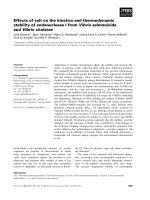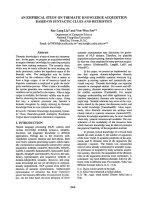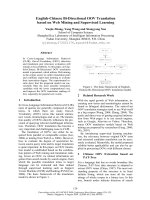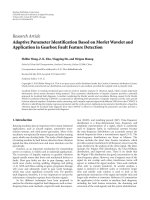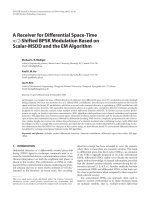Foot behavior during walking based on foot kinetics and kinematics
Bạn đang xem bản rút gọn của tài liệu. Xem và tải ngay bản đầy đủ của tài liệu tại đây (5.7 MB, 214 trang )
FOOT BEHAVIOR DURING WALKING BASED ON
FOOT KINETICS AND KINEMATICS
WANG XUE
(B. ENG)
A THESIS SUBMITTED
FOR THE DEGREE OF DOCTOR OF PHILOSOPHY
DEPARTMENT OF MECHANIMCAL ENGINEERING
NATIONAL UNIVERSITY OF SINGAPORE
2012
I
II
ABSTRACT
As most falls of aging population occur during walking, evaluation of walking
behavior is important to understand the falls. Other clinical problems related to
walking also require standard and improved methods for gait analysis. Many previous
studies focused on gait analysis related to hip, knee and ankle motion and considered
the foot as one rigid segment; however the foot is composed of multi-segments and
joints. The foot behavior during walking is not yet well investigated. Useful
information or features obtained from the foot dynamic behavior study could help to
indicate normal and pathological gait, and will benefit clinical issues related to walking
problems or foot dysfunctions. Hence, the objective of this thesis is to study the foot
behavior during walking based on foot kinetics and kinematics, to extract useful foot
dynamic features, and to model the foot dynamics.
For the foot kinetics, as foot pressure is much related to walking behavior, some
features are extracted from foot pressure to depict the whole foot pressure changes
during walking. These features could reflect kinetic information such as the foot center
of pressure trajectory, and the foot pressure repeatability between strides. The foot
pressure features are further applied for quantitative walking stability evaluation.
Results show that some of the proposed foot pressure features work well in foot
behavior characteristics description. In addition, the whole foot pressure is divided into
sub-areas to investigate the segment pressure changes for foot behavior. However, the
foot pressure is only 2D information. Thus, 3D foot motion is also analyzed for better
understanding of foot behavior.
For the foot kinematics study, the 3D foot motion features are extracted. The foot
motion features include joint rotation angles between sub-defined foot segments, and
some proposed functional angles for describing the whole foot physical features of
III
walking. The results show that time-histories of the joint rotation angles present good
agreement with previous literature. The results of four proposed functional angles are
consistent with walking physics and can more intuitively describe foot kinematic
behavior with good repeatability. Angle values at the mid-stance are proposed as
dynamic reference positions, which perform well for reducing variance among subjects.
In addition, different conditions are designed to enable subjects to walk in less stable
conditions. Extracted foot motion features are applied to designed different walking
conditions for their effectiveness on describing foot behavior characteristics. The
current study provides evidence that the values of some foot motion features present
significant difference in different walking conditions. Data of selected motion features
are further processed with pattern recognition method for automatically classifying
these walking conditions.
Finally, to better understand the foot kinetics and kinematics during walking, the
relationship between foot segment pressure/force and motion is studied through
modeling of the multi-segment foot. For foot dynamic function, modeling and
simulation can be a good choice. For this purpose, a multi-segment foot model is built
with LifeMOD biomechanics modeling toolbox. One normal walking and one
abnormal walking are modeled. The simulated results from detailed foot model match
well with the experiment data. This simulation provides a better visualized, relatively
convenient, and thorough method for analyzing and understanding relationship among
foot segment kinetic features, foot segment kinematic features and walking behaviors.
In conclusion, the foot dynamic behavior characteristics are studied through foot
dynamic features extraction. The study could benefit many applications such as foot
function investigation, shoe design industry, and clinical issues related to the foot.
IV
ACKNOWLEDGEMENT
First and foremost, the author would like to express her deepest gratitude to
Professor Lu Wen Feng, for his dedicated supervision, patient guidance and great
support. This project would not have possibly reached this stage without his counsel
support and guidance. Professor Lu Wen Feng is always very helpful and considerate.
He is not only a great supervisor, but also a good friend, who shares life experiences
and instrumental suggestions on all perspectives of life.
The author would like to express her most sincere appreciation to Professor Wong
Yoke San and Professor Loh Han Tong, for their invaluable advices and continuous
guidance. They have been very helpful throughout the process by giving critical
advices and concerns for the project. Due to discussion with them, the author could
have smooth and controlled research progress.
The author is very grateful to Singapore Polytechnic’s Lecturer, Dr. Ong Fook
Rhu, for his valuable advices, great support and sharing his knowledge. He is very
experienced in using the equipment and his advices have been vital in data collection
and analysis. Without his aid, this project would not have been successful.
The author would also like to thank Singapore Polytechnic’s Lab officers, Mr.
Lawrence and Mr. Yu Boon Tat, for their assistance in operations of the facilities in
Singapore Polytechnic Biomechanics Lab.
The author would also like to thank the final-year project students, Mr. Julian Yeo,
Mr. Ong Wua Wei, Mr. Lim Boon Tah, Ms. Shifali Jamwal and Mr. Nadzri Hussain
for useful discussions and help.
The author would like to thank Mr. Huynh Kim Tho, Ms. Khatereh Hajizadeh,
and Ms. Huang Meng Jie for their sharing research experience of LifeMOD modeling.
V
The author would like to thank Ms. Wang Jinling, Ms. Wang Yan, Mr. Wang
Jingjing, Mr. Zheng Fei, Ms. Asma Perveen, Ms. Li Hai Yan, Mr. Indraneel Biswas,
Mr. Hesamoddin Ahmadi and all the other labmates for their companion, support and
encouragement.
The author also would like to thank Mr. Chen Xue Tao, for his understanding,
encouragement and support. He takes pressure from the author and brings happiness.
Finally the author would express her deepest appreciation to her parents Mr. Wang Fu
Lin and Ms. Wo Su Rong. With their love and support, the author could overcome the
most difficult time during the PhD study. Although they are far away in China, but the
author can feel their support and encouragement anytime, anywhere and feel they are
always by her side.
VI
CONTENTS
ABSTRACT I
ACKNOWLEDGEMENT IV
CONTENTS VI
LIST OF TABLES XI
LIST OF FIGURES XIII
CHAPTER 1 INTRODUCTION 1
1.1BACKGROUND 1
1.2 PROBLEM IDENTIFICATION 4
1.3 OBJECTIVE 7
1.4 ORGANIZATION OF THE THESIS 7
CHAPTER 2 LITERATURE REVIEW 9
2.1 FOOT PRESSURE RELATED ISSUES 9
2.1.1 Foot pressure relief 9
2.1.2 Foot pressure analysis for diagnoses 10
2.1.3 Pressure related gait analysis 13
VII
2.2 FOOT MULTI-SEGMENT MOTIONS 15
2.3 DYNAMIC MODELING OF FOOT KINEMATICS AND KINETICS 17
2.4 SUMMARY 19
CHAPTER 3 PROPOSED FRAMEWORK 22
CHAPTER 4 IDENTIFY FEATURES FROM FOOT PLANTAR PRESSURE
PATTERNS 27
4.1 FOOT PRESSURE FEATURES BASED ON COP TRAJECTORY 29
4.1.1 Proposed pressure features 29
4.1.2 Experiment set-up 30
4.1.3 Experiment data analysis methods and calculations 33
4.1.4 Results and discussion 38
4.2 FOOT PRESSURE FEATURES BASED ON PRESSURE REPEATABILITY BETWEEN STRIDES
43
4.2.1 Proposed pressure features 43
4.2.2 Experiment design 45
4.2.3 Results and discussion 46
4.3 MULTI-SEGMENT FOOT PRESSURE 54
4.4 SUMMARY 57
CHAPTER 5 IDENTIFY FEATURES FROM FOOT MOTIONS 60
5.1 INTRODUCTION 60
VIII
5.2 FOOT MOTION MEASUREMENT 61
5.2.1 Foot structure and segments division 61
5.2.2 Experiment set-up 63
5.3 FOOT MOTION FEATURES 69
5.3.1 Joint motions calculation 69
5.3.2 Functional angles calculation 71
5.4 RESULTS 73
5.4.1 Joint motions 73
5.4.2 Functional angles 80
5.5 DISCUSSION 84
5.6 SUMMARY 88
CHAPTER 6 APPLICATION OF FOOT MOTION FEATURES ON
WALKING STABILITY DESCRIPTION 91
6.1 INTRODUCTION 91
6.2 EXPERIMENT DESIGN 93
6.3 DATA COLLECTION AND ANALYSIS 95
6.3.1 Foot motion features 95
6.3.2 Statistical analysis 96
6.4 RESULTS OF MOTION FEATURES 98
6.4.1 Arch angle 98
6.4.2 Push off angle 100
6.4.3 Shank-foot (foot motion relative to the shank) 103
6.4.4 Shank-heel (heel motion relative to the shank) 106
IX
6.4.5 Heel-mid (Mid-foot motion relative to the heel) 109
6.4.6 Mid-met (Metatarsal motion relative to the mid-foot) 112
6.4.7 Heel-Met (Metatarsal motion relative to the heel) 112
6.4.8 Stance duration and toe clearance 114
6.5 DISCUSSION OF MOTION FEATURES 114
6.6 PATTERN RECOGNITION USING FUZZY LOGIC SYSTEM WITH SELECTED MOTION
FEATURES
118
6.6.1 Fuzzy logic system 119
6.6.2 Adaptive fuzzy logic system 121
6.6.3 Motion pattern recognition with adaptive fuzzy logic system 123
6.7 SUMMARY 126
CHAPTER 7 DEVELOP A MULTI-SEGMENT FOOT MODEL TO
INVESTIGATE FOOT SEGMENT FEATURES 128
7.1 INTRODUCTION OF LIFEMOD 129
7.2 PROPOSED MODELING OBJECTIVES AND SCOPES 132
7.3 LIFEMOD MODELING FOR NORMAL WALKING 134
7.3.1 Build a LifeMOD model for normal walking trial 134
7.3.2 Simulation results for normal walking 143
7.3.3 Data analysis for normal walking 145
7.3.4 Discussion of the normal walking model 154
7.4 LIFEMOD MODELING FOR WALKING WITH DRAGGING WEIGHTS 155
7.4.1 Build a LifeMOD model for walking with dragging weights 155
7.4.2 Simulation results for walking with dragging weights 156
X
7.4.3 Data analysis for walking with dragging weights 158
7.4.4 Discussion of the dragging weights walking model 167
7.5 SUMMARY 167
CHAPTER 8 CONCLUSIONS AND FUTURE WORKS 169
8.1 CONCLUSIONS 169
8.2 FUTURE WORKS 172
REFERENCES 175
APPENDIX A RESULTS OF FOOT PRESSURE FEATURES A1
APPENDIX B LIFEMOD MODELING EXAMPLE B1
APPENDIX C FORCE PATTERN DURING NORMAL WALKING AND
WALKING WITH DRAGGING WEIGHTS C1
XI
LISTOFTABLE S
Table 4.1: Experimental conditions 32
Table 4.2: Combined data for six features; Test subject 1 39
Table 4.3: Combined data for six features; Test subject 2 41
Table 4.4: Experimental conditions 45
Table 4.5: Mean and std of NCSS of six tested subjects 53
Table 5.1: Experiment marker sets 66
Table 5.2: Defining vectors and origins used to establish the local segment-fixed
reference system 67
Table 5.3: Averaged standard deviations (ASD) for five tested subjects 79
Table 5.4: Coefficients of multiple correlations (CMC) for five tested subjects 79
Table 6.1: Comparison of averaged arch angle values at some gait events between
normal walking and each less stable walking condition 99
Table 6.2: Comparison of typical values between normal walking and each less stable
walking condition for arch angle and push off angle 102
Table 6.3: Comparison of averaged push off angle values at some gait events between
normal walking and less stable walking conditions 102
Table 6.4: Comparison of typical values between normal walking and each less stable
walking condition for shank-foot angle and shank-heel angle 105
Table 6.5: Comparison of typical joint motion values between normal walking and
each less stable walking condition 107
Table 6.6: Comparison of typical values between normal walking and each less stable
walking condition for heel-mid angle, mid-met angle and heel-met angle 110
Table 6.7: Confusion matrix for training data 126
XII
Table 6.8: Confusion matrix for test data 126
Table 7.1: Parameters for refined left foot segments 135
XIII
LISTOFFIGURES
Figure 3.1: The theme of this study 22
Figure 3.2: A main framework of the whole project 26
Figure 4.1: A general diagram of foot pressure features extraction for foot behavior
description 28
Figure 4.2: F-Scan research software interface 31
Figure 4.3: Experiment set-up using Tekscan equipment measuring foot plantar
pressure 32
Figure 4.4: Pressure magnitude of sampled frame data 34
Figure 4.5: COP coordinates data 35
Figure 4.6: Sampled foot plantar pressure frame patterns 35
Figure 4.7: Total force exerted versus frame number; Experiment A (top) and D
(bottom) 36
Figure 4.8: Mean and standard deviation of Features 1 to 6 across experimental
conditions A to D; Test subject 1 40
Figure 4.9: Mean and standard deviation of Features 1 to 6 across experimental
conditions A to D; Test subject 2 42
Figure 4.10: Total force (kg) exerted during multiple strides of condition 1 (normal
walking) 47
Figure 4.11: Total force (kg) exerted during multiple strides of condition 2 (eye closed)
47
Figure 4.12: Total force (kg) exerted during multiple strides of condition 3 (eye closed
after being spun) Left foot (real line), right foot (dash line) 47
Figure 4.13: Example of comparison between two subsequent strides of condition 1 . 48
XIV
Figure 4.14: Example of comparison between two subsequent strides of condition 2 . 49
Figure 4.15: Example of comparison between two subsequent strides of condition 3 . 50
Figure 4.16: Mean and std of NCSS of six subjects (triangle: left foot; diamond: right
foot) 51
Figure 4.17: Correlation coefficient distribution for the three walking conditions 54
Figure 4.18: Multi-segment foot pressure regions 55
Figure 4.19: Multi-segment foot pressure for normal walking 55
Figure 4.20: Multi-segment foot pressure for walking with eyes closed after being spun
in the chair 56
Figure 4.21: Details of the pressure features extracted from 2D plantar pressure for the
application of walking stability 59
Figure 5.1: Foot bone structure 62
Figure 5.2: Foot segments and local coordinate 63
Figure 5.3: Vicon motion cameras and their positions during experiments 64
Figure 5.4: Positions of the markers for static calibration 64
Figure 5.5: Standard wand with three reflective markers for dynamic calibration 65
Figure 5.6: Experiment marker set (a) anterior view (b) posterior view 66
Figure 5.7: Captured raw marker positions in Workstation 67
Figure 5.8: Labeled marker positions in Workstation 68
Figure 5.9: Patching up the trajectories in Bodybuilder 68
Figure 5.10: Setup five local coordinates on each foot segment in Bodybuilder 69
Figure 5.11: Motion in sagittal, coronal and transverse planes 70
Figure 5.12: The three phases of a stance 71
Figure 5.13: Definition of Angle 1 for weight bearing arch changes 72
Figure 5.14: Definition of Angle 2 for windless mechanism 72
XV
Figure 5.15: Definition of Angle 3 for push off feature 73
Figure 5.16: Definition of Angle 4 for ankle flexibility feature 74
Figure 5.17: Five averaged joint motions of 3 trials from one subject in three planes.
(a) Sagittal plane (positive: Dosi-flexion/negative: Plantar-flexion) (b)
coronal plane (positive: Eversion/negative: Inversion) (c) transverse plane
(positive: Abduction/negative: Adduction); Mean (real black line), ±1 S.D.
(red dotted line), 20% and 80% mark (green vertical dotted line) 77
Figure 5.18: Five averaged joint motions of 15 trials from five subjects in three planes.
(a) Sagittal plane (positive: Dosi-flexion/negative: Plantar-flexion) (b)
coronal plane (positive: Eversion/negative: Inversion) (c) transverse plane
(positive: Abduction/negative: Adduction); Mean (real black line), ±1 S.D.
(red dotted line), 20% and 80% mark (green vertical dotted line) 78
Figure 5.19: Angle 1 for foot arch dynamic feature 81
Figure 5.20: Angle 2 for fore-foot and hind-foot windless mechanism 82
Figure 5.21: Angle 3 for push off feature (a) one trial (b) three trials comparison 83
Figure 5.22: Angle 4 for ankle flexibility feature 84
Figure 5.23: A comparison between Shank-Heel sagittal angle calculated with static
and dynamic references (a) angles calculated with static reference (b)
mean and STD calculated with static reference (c) angles calculated with
dynamic reference (d) mean and STD calculated with dynamic reference
86
Figure 5.24: Details of the motion features extracted from 3D foot multi-segment
motion 90
Figure 6.1: Double Beam condition 94
Figure 6.2: Single Beam condition 94
XVI
Figure 6.3: Dragging of Weights Condition 95
Figure 6.4: Arch angle (left) and push off angle (right) 96
Figure 6.5: Typical T-test curve and P-value 98
Figure 6.6: Arch change feature for four walking conditions (+,extension;-contraction).
(Standard deviations are not shown to improve clarity) 99
Figure 6.7: Averaged push off feature for four walking conditions 101
Figure 6.8: Averaged shank-foot angles in sagittal, coronal and transverse planes for
four walking conditions 104
Figure 6.9: Averaged shank-heel angles in sagittal, coronal and transverse planes for
four walking conditions 108
Figure 6.10: Averaged heel-midfoot angles in sagittal, coronal and transverse planes
for four walking conditions 111
Figure 6.11: Averaged midfoot-metatarsal angles in sagittal, coronal and transverse
planes for four walking conditions 113
Figure 6.12: Averaged heel-metatarsal angles in sagittal, coronal and transverse planes
for four walking conditions 115
Figure 6.13: Basic configuration of a fuzzy logic system 119
Figure 7.1: LifeMOD biomechanics modeling process 130
Figure 7.2: Import SLF model file with subject information 134
Figure 7.3: Lower body segments (foot is initially generated as one rigid segment) . 135
Figure 7.4: Single segment creation panel in LifeMOD 136
Figure 7.5: Refined foot segments 136
Figure 7.6: Segment delete panel 136
Figure 7.7: Create basic joint set 137
Figure 7.8: Create individual joint 138
XVII
Figure 7.9: Created joint set 138
Figure 7.10: Experiment set up for measuring both foot motion and pressure during
walking 139
Figure 7.11: Motion agents (standard and augmented motion agents) 140
Figure 7.12: Motion agents after equilibration 140
Figure 7.13: Contact parameters used in the feet floor interactions 141
Figure 7.14: Create contacts between foot segments and ground 142
Figure 7.15: Analyze panel set to run inverse-dynamics simulation 142
Figure 7.16: Normal walking simulation result for contact forces with single segment
foot 143
Figure 7.17: Normal walking simulation result for contact forces of refined foot model
144
Figure 7.18: Contact force comparison between simulated results and experimental
results 144
Figure 7.19: Ankle joint motion comparison between simulated results 145
Figure 7.20: Shank-Heel sagittal plane angle feature (red line) VS contact forces 146
Figure 7.21: Foot and ankle motion before mid-stance, at mid-stance and after
mid-stance 147
Figure 7.22: Shank-Heel coronal plane angle feature (red line) VS contact forces 148
Figure 7.23: Eversion starting to occur 148
Figure 7.24: Foot is nearly neutral in the transverse plane 149
Figure 7.25: Heel-Midfoot sagittal plane angle feature (red line) VS contact forces . 149
Figure 7.26: Heel-Midfoot coronal plane angle feature (red line) VS contact forces 150
Figure 7.27: Heel-Midfoot transverse plane angle feature (red line) VS contact forces
150
XVIII
Figure 7.28: Midfoot-Metatarsal sagittal plane angle feature (red line) VS contact
forces 151
Figure 7.29: Metatarsal initial contact with ground 151
Figure 7.30: Midfoot-Metatarsal coronal plane angle feature (red line) VS contact
forces 152
Figure 7.31: Midfoot-Metatarsal transverse plane angle feature (red line) VS contact
forces 152
Figure 7.32: Metatarsal-Hallux sagittal plane angle feature (red line) VS contact forces
153
Figure 7.33: Dorsiflexion at maximum on Hallux before TO 153
Figure 7.34: Walking with dragging weights (Left: experiments; Right: LifeMOD
modeling) 156
Figure 7.35: Walking with dragging weights simulation result for contact forces of
refined foot model 157
Figure 7.36: Contact force comparison between simulated results (Dotted) and
experimental results (Solid) (X axis: time steps; Y axis: force values) . 157
Figure 7.37: Ankle joint motion comparison of one stance between simulated results
(solid) and experimental results (dotted) for walking with dragging
weights 158
Figure 7.38: Shank-Heel sagittal plane angle feature (solid, red line) VS contact forces
(Walking with Weights) 159
Figure 7.39: Left foot at Heel Strike and Mid-stance (Walking with weights) 160
Figure 7.40: Shank-Heel coronal plane angle feature (solid, red line) VS contact forces
(Walking with Weights) 160
Figure 7.41: Heel eversion after MS (Walking with Weights) 161
XIX
Figure 7.42: Shank-Heel transverse plane angle feature (solid, red line) VS contact
forces (Walking with Weights) 161
Figure 7.43: Heel-Midfoot transverse plane angle feature (solid, red line) VS contact
forces (Walking with Weights) 162
Figure 7.44: Heel-Midfoot coronal plane angle feature (solid, red line) VS contact
forces (Walking with Weights) 163
Figure 7.45: Heel-Midfoot transverse plane angle feature (solid, red line) VS contact
forces (Walking with Weights) 163
Figure 7.46: Midfoot-Metatarsal sagittal plane angle feature (solid, red line) VS
contact forces (Walking with Weights) 164
Figure 7.47: Force distribution on the left foot near mid-stance (Walking with Weights)
164
Figure 7.48: Midfoot-Metatarsal coronal plane angle feature (solid, red line) VS
contact forces (Walking with Weights) 165
Figure 7.49: Midfoot-metatarsal transverse plane angle feature (solid, red line) VS
contact forces (Walking with Weights) 166
Figure 7.50: Hallux, metatarsal and mid-foot during TO 166
1
CHAPTER1 INTRODUCTION
1.1 Background
As the population demographics shift during these several decades, aging and
associated health risks are becoming increasingly important. Falls are a large cause of
morbidity and mortality in the elderly people. Approximately 35% to 40% of healthy
elderly people fall annually. Around 40-60% of falls results in injuries [1]. As most
falls occur during walking, evaluation of walking behavior could be essential and
helpful. Poor stability during walking leads to decreased life quality. Two methods of
evaluating walking behavior are mostly used at present: one is through qualitative
observation from experiences of physical therapists; the other one is through
quantitative measurement of gait analysis by motion cameras. For quantitative
measurement of gait analysis, many studies have been done for the whole body gait
analysis or lower body gait analysis, which are more focused on the hip, knee and
ankle motion study and consider the foot as one rigid body [2, 3].
In fact, the foot behavior is quite complex and closely related to the lower body
function. 52 bones are in the feet, which are nearly one quarter of all body bones. The
unique foot structure allows it to absorb the shock during foot strike and is rigid
enough to push off the ground at the end of the stance phase. It works in conjunction
with the lower body: ankle, knee, hip and lower back. While only a few studies are
focused on the foot behavior, the foot is not yet well investigated for its behavior
during walking. For foot dynamic behavior study, many experimental techniques were
developed and employed, such as pressure sensing platforms [4], gait analysis [5, 6]
and cadaveric anatomic experiments [7]. The first two methods are relatively easier
2
implemented. Most of the foot dynamic behavior studies have concentrated on the
kinetic analysis and kinematic analysis. The kinetic analysis is processed with force
and pressure plates for the force or pressure distribution during walking. On the other
hand, the kinematic gait analysis could include dorsi-flexion/plantar-flexion,
inversion/eversion, and abduction/adduction movements of fore-foot, mid-foot and
hind-foot. Both the foot kinetics and foot kinematics are very important and could be
measured with commercial equipment and further analyzed. Focusing on the foot
dynamic behavior will benefit clinical problems related to walking problems or foot
dysfunctions. To best describe foot behavior characteristics, foot kinetics and
kinematics features could be extracted. To identify the features for foot dynamic
behavior characteristics is very important and quite difficult, because the foot has
complex structure and function. Useful features obtained from the foot dynamic
behavior study could be accumulated to form database. The database could contain
foot kinetic or kinematic features to indicate normal and pathological gait. For example,
the diabetic patients tend to have higher pressure under metatarsals and different
dorsi/plantar-flexion [8]. This will be very clinically important and helpful for disease
prescription and solution. The feature data base could also provide useful information
for customized shoe design industry. Once you know what type of foot you have, such
as the foot with over pronation tendency, shoes that complement your feet should be
selected.
For the foot kinetics, foot plantar pressure can be measured and analyzed to
provide kinetic information. One main advantage of studying foot pressure is that the
foot pressure could be relatively easily measured and the equipment is portable and
relatively cheap. During the past several decades, foot plantar pressure information has
been used in diverse fields such as in commercial shoe design, clinical applications and
3
sports medicine [9-11]. One of the most popular applications of foot plantar pressure
research is to reduce the peak plantar pressure for comfortable walking of normal
people and ulcers prevention for diabetic patients. Foot plantar pressure information is
also widely used as a part of gait analysis for disease detection for patients with
walking problems [12]. Different people would have different foot pressure during
various behaviors. Foot plantar pressure can be an important indication of the foot
kinetics and walking behavior. However, the foot pressure is only providing the 2D
information and is a bit indirect and implicit, thus the 3D foot motion also needs to be
measured and analyzed for studying the foot dynamic behavior characteristics.
Compared with the 2D plantar pressure, the 3D foot motions are more intuitional
understood because they are directly reflecting the walking behavior by showing
different attitude of the foot. On the other hand, the 3D foot motion could provide
useful foot kinematics information. Since these foot motions are greatly influenced by
the person’s control ability and lower body function, the foot motions should be able to
perform as an indication of the walking behavior. Traditional approach would consider
the foot as one rigid segment although the foot has complex intrinsic structure and
interactions. In recent studies, the foot is divided into multi-segments such as the
metatarsals, toes, and calcaneus for 3D foot motion study [13]. Since the 3D foot
motion study is a relatively new area, it is still in its infancy. There are complex
motions between the adjacent segments of the foot during walking. Although large
variances of the motions exist, some consistent motions can be identified for certain
group of people.
Besides the experimental methods, many empirical and physical-based
computational models, such as mathematical models, finite element models and
kinematic models have been developed [14]. For gaining insight to the function of
4
specific foot structures, very complex models are useful, while for gaining overall foot
dynamic function, simple kinematic models can be a good choice. Modeling and
simulation of foot force and motion could provide better visualization. Through the
model, simultaneously looking into foot kinetics and kinematics could help to better
understand foot dynamic behavior from a new perspective. The dynamic foot model
could present the relationship between foot force and foot motion, and combined
function of foot kinetic and kinematic features. As a result, the foot dynamic behavior
characteristic could be analyzed from the developed foot model’s point of view.
Furthermore, with verified foot dynamic model, various simulations with different
kinematics could be investigated. The activities of some muscles or tendons, which are
difficult to be obtained through real experiments, could also be possibly simulated.
Thus, to enhance the understanding of foot dynamic behavior, a modeling method
could be used to integrate foot kinetics and kinematics features.
1.2 Problemidentification
As mentioned in Section 1.1, the foot kinetics and kinematics behavior
characteristics during walking are not yet well investigated, although many studies
were performed for walking behavior description. To describe foot dynamic behavior
characteristics, features that can best depict foot behavior characteristics need to be
extracted from both foot kinetic and kinematic studies. The features of foot dynamic
behavior could possibly be collected to form a foot feature database for healthy gait
and pathological gait. As more data will be collected into the feature database, pattern
recognition method could also be proposed and applied to automatically classify
healthy/pathological gait pattern. If a person’s walking features are identified through
pattern recognition as similar to one group of patients’ in the feature database, this
person could be considered to have similar foot behavior or disease with quantitative
5
proof. Thus, investigation of foot dynamic behavior could benefit clinical foot/walking
related disease identification and solution. Moreover, useful foot features could also be
possibly measured and integrated in shoes to provide real time walking behavior
information. In a word, the foot dynamic features extraction could benefit multiple
areas such as foot function investigation, shoe design industry and clinical issues
related to the foot.
Since the study of foot dynamic behavior is very important with many benefits,
this thesis will focus on foot dynamic behavior based on foot kinetics and foot
kinematics. For best describing foot dynamic behavior characteristics, effort will be
put on extracting effective features from both the foot plantar pressure for the foot
kinetics, and foot motion for the foot kinematics. Additionally, combined foot kinetic
and kinematic features, as well as the relationship between foot kinetic and kinematic
features need to be investigated. However, the foot dynamic features are not easy to be
extracted because of the complexity in the foot structure and dynamics. Considering
the difficulties, foot could be investigated from both one whole foot’s function, and
foot multi-segments’ function, for studying the foot kinetic and kinematic behavior
characteristics.
For the foot kinetics, features could be extracted to describe the whole foot
function and foot segment kinetic function. Foot pressure during walking can be
directly recorded as foot plantar pressure patterns through commercial pressure
measurement equipment. Some features extracted from plantar pressure might provide
useful foot kinetic information. However, the effectiveness of these foot pressure
features still needs to be investigated and more effective foot pressure features need to
be extracted. Although some kinetic features could be extracted from the foot plantar
pressure pattern, the foot plantar pressure only provides 2D information and is not

